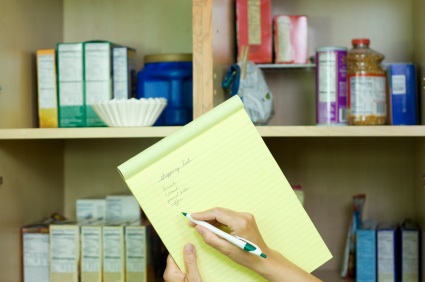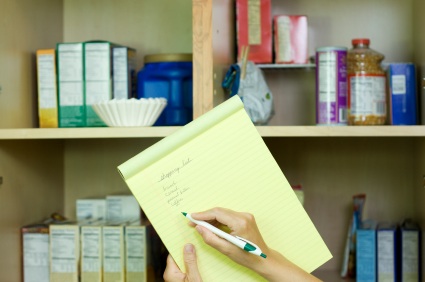 Dear Lou,
Dear Lou,
As a resident of South Mississippi, I think it is officially time to stock my swine flu/tornado/hurricane/foreign invasion pantry. How do I do this without filling it with a bunch of processed crap, but still manage to stock away flavorful and nutritious staples?
Kelly S.
Dear Kelly,
This particular swine flu pandemic–which may or may not be linked to factory farms–doesn’t appear to pose much of a public-health menace. But it reminds us of an old lesson: chaos happens. Regarding pandemics, our very own government advises people to keep two weeks’ worth of supplies on hand, which is truly the least the government can do given its recent disaster track record. You don’t have to be a Chuck Norris-obsessed, gun-packing paranoiac to stash a bit of canned food and water in case of hard times.
You’re worried about foreign invasion, huh? While keeping a sharp lookout for an armada in the Gulf, consider these tips before heading to the store for batteries and canned tuna:
• Don’t spend too much time obsessing about flavor. “Keep it simple. Realize what the intention is, which is survival,” explains Cody Lundin, founder of the Aboriginal Living Skills School in Prescott, Arizona. “Survival is different from living, technically. You might be eating weird shit, including the dog.” Of course, you won’t need to eat the dog if you’re prepared, which is the point of his hilarious book When All Hell Breaks Loose.
• The amount of food to stock is up to you and your available storage space. If you’re short on space, you may only be able to keep few day’s worth of food on hand (tip: store stuff under your bed, if you can secure the containers against your always-curious toddler). If you are unsure about how much food you and your family will need, check out this calculator, courtesy of the Latter Day Saints. (Note: the calculator is based on stocking food for one year, so you’ll have to do a little extra math if you want a smaller pantry.) Yes, as it turns out, the Mormon church does indeed advise its members to keep a year’s worth of supplies in their pantries. As a spiritual traveler you might be curious, so here’s why.
• Label and date everything in your pantry and adhere to the FIFO (first-in, first-out) rule. The last thing you want to discover during an emergency is that your rice has bugs in it and all the tomato soup expired two years ago. If you are not going to rotate foods in and out regularly (isn’t that what they do with Congressmen and lobbyists in Washington?), consider (gasp!) buying more processed foods, at least for some things. More heavily processed foods tend to keep longer. For instance, Lundin prefers white rice for long-term storage — it keeps longer than brown rice, which contains oil that oxidizes. “The really healthy, groovy dark olive oil oxidizes like crazy,” says Lundin. Which fat stores the longest? “Unfortunately, it’s [expletive] Crisco, ” he says. Bottom line: If you leave things in the refrigerator until they grow fuzzy coats, you might want to consider foods that store a really long time.
• Don’t rush out and buy foods that your family normally wouldn’t eat. My husband and I purchased a bunch of powdered non-fat milk for Y2K. Here it is almost Y2K + 10, and we’ve still got it. I wouldn’t eat the dog before using it, but it’s going to be one of the last things to go into my mouth when the power goes out/ice storm hits/government ceases to function/all of the above.
• Because the growing season is well underway in Mississippi, start planning along with your planting. Preserve some of this year’s fresh, nutritious bounty from your garden or farmer’s markets. For home-preservation advice, click here.
• Use food-grade plastic containers and bags for storage. If you are going to use non-food grade buckets, such as those big paint buckets you get at Home Depot, Lundin suggests that you store your food-grade Ziploc bags first. Herewith, my oft-repeated ditty about which kinds of plastic to use, courtesy of the Institute for Agriculture and Trade Policy: “With your food use 5, 4, 1, and 2. Three and 6 aren’t good for you. And 7 sucks big-time.” (That last bit was my addition–don’t give me a guitar.) Glass is environmentally friendly but it has emergency storage drawbacks –containers tend to be small, light-permeable, and breakable. That last one is a bummer if you’re hit by an earthquake (or, say, rampaging toddlers).
Next, here’s a Gristed-up list of things to stock:
• Preserved meats, fish, fruits, vegetables, beans, and soups. On one hand, canned foods are often full of additives, salts, etc., and even the healthy ones may come in cans with plastic liners that contain bisphenol-A. On the other hand, Lundin points out that canned food is easy to acquire and stores for at least two years. “Try to get stuff you can eat right out of the can,” he suggests, “When you’re talking about emergency cooking, there’s going to be fuel shortages.” My tip: Instead of tuna consider skinless, boneless sardines that are chock full of Omega fatty acids, and sustainable – lower on the food chain and also lower in mercury.
• Protein/fruit/granola bars. Look for the ones without any HFCS or unpronounceable ingredients. My coop grocery store, which provided three emergency pantry lists last month (vegan, gluten-free and one for regular folks), suggests Cascadian Organic granola bars and Stretch Island fruit leathers.
• Dry cereal or granola. Granola is ridiculously easy to make and nutrient-dense: Here’s one recipe.
• Dried fruits, grains and nuts. If you can, choose organic and buy in bulk to save money. For more money saving tips here. Also consider nut butters. When I don’t buy them in bulk, I often buy Woodstock nut butters.
• Crackers: Buy high-quality, high-fiber ones. There are some brands in my pantry that will not only keep you regular during times of stress, but also may be used to re-shingle the roof after a hurricane strikes.
• Baby food and/or formula if you need it.
• Vitamins. The idea here is that if your nutrition suffers, you can boost it with vitamins.
• Juice, plus fluids with electrolytes. Don’t just reach for your average “sports drink,” which may be loaded with lots of sugar and carbs rather than the salts and minerals your body needs to rehydrate in the event of an illness. This is the one I keep on hand.
• Water: This is key. “Water is a not-optional item. If you don’t have it, you die,” says Lundin, who suggests doubling the standard recommendation of one gallon per person per day. Also, consider storage carefully because, as Lundin points out, water is heavy (8.3 pounds per gallon). “If you live on the 24th floor of an apartment and you want to put 1,000 pounds of water weight over four square feet in your closet–that’s a bad move.” At the moment, our family uses plastic jerrycans, the ones used for camping.
• Pet food. Reach for the good stuff.
Lastly, here’s a list of non-food stuff to have on hand:
• Soap, or alcohol-based (60-95%) hand wash.
• Any prescription meds your family needs, plus a basic first-aid kit that includes a thermometer, fever meds such as acetaminophen or ibuprofen, and anti-diarrheal meds.
• Flashlights: If your flashlights use rechargeable batteries, good for you, but if the power goes out you wont be able to plug in the recharger. Consider a hand-crank flashlight (my tiny hardware store carries them) or solar-powered ones and/or emergency candles.
• Portable radio. Here’s one that operates on solar, hand-crank or battery power and has a built-in cell phone charger and flashlight.
• Manual can opener. Lundin recommends Swing-A-Way can openers because they “last and last and last” or P-38 can openers, which you can get online or at military or outdoor stores. He keeps a P-38 on his keychain. Watch Lundin open a can using a concrete curb in this clip.
• Garbage bags: Use them for trash, make-shift sleeping bags (Lundin-style, filled with newspaper) or the removal of a corpse (but let’s not dwell on that). Get strong ones!
• Tissues, toilet paper, diapers (if water is in short supply, you won’t be washing cloth diapers, so go for disposable eco diapers) and feminine hygiene supplies.
• Extra strings for your viola.
Now here’s the weird thing about all of this. You’d think it would be morbid or depressing to store up for the apocalypse. But it’s not– found it empowering and liberating. Do it, and you’ll be more in control of your fate and perhaps much less hysterical. That’s always a great feeling, no matter what the storm clouds (or flu bugs) are doing.
Your Fellow Yankee,
Lou Bendrick


